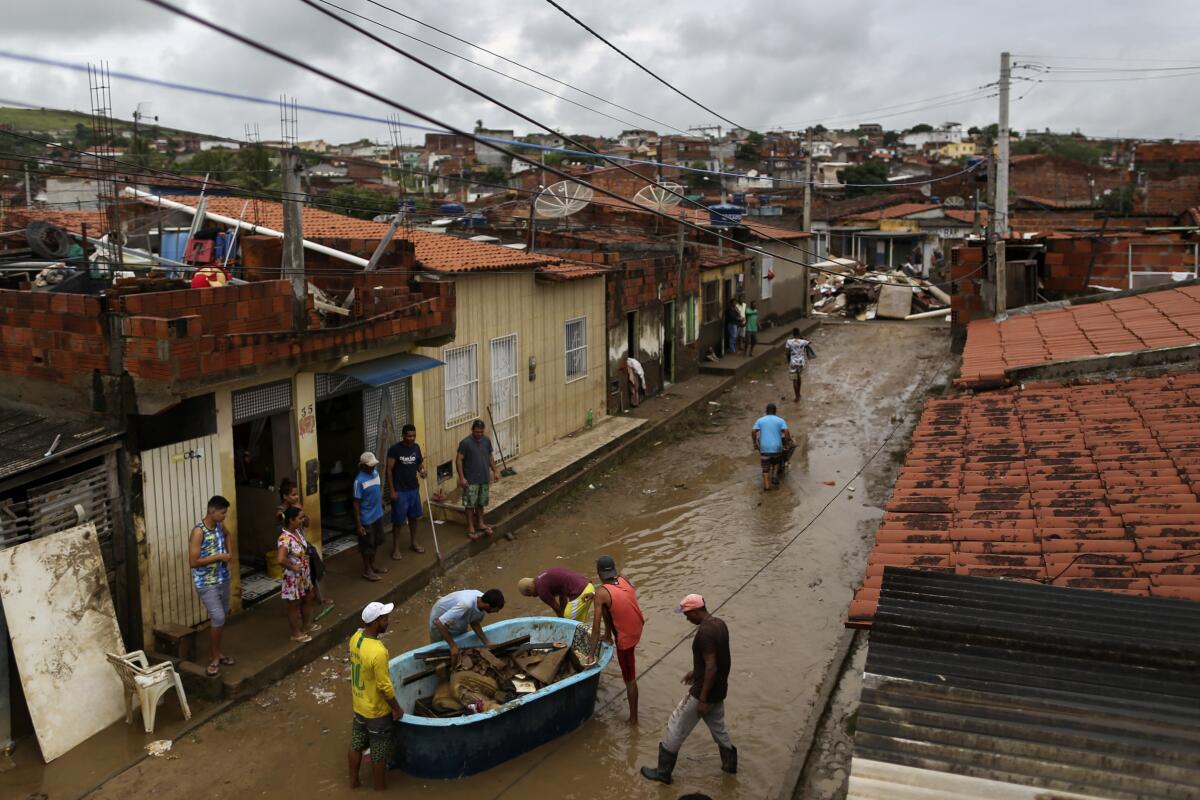Severe flooding in Brazil spreads in Bahia state and beyond

- Share via
BRASILIA, Brazil — A total of 116 cities in the northeastern Brazilian state of Bahia were in a state of emergency because of flooding on Tuesday due to heavy rains that have been pounding the region since the end of November.
Cities in at least five other states in Brazil’s north and southeast have also been flooded in recent days.
In Bahia, flooding has affected more than 470,000 people. In at least 50 cities, water surged into homes and businesses, and people were forced to abandon their belongings. Official data from the state government say 34,163 people have been made homeless and almost 43,000 are displaced. There have been a total of 21 deaths and 358 people injured since the beginning of the month.
This is the heaviest period of rainfall for Bahia in the last 32 years, according to the website of the National Center for Monitoring and Alerts of Natural Disasters, a government agency. In southern Bahia, it rained more than five times the normal amount for this time of the year.
In an interview with local radio stations Tuesday morning, Bahia Gov. Rui Costa compared the situation to a “bombardment.” He also said that coronavirus vaccines were lost in the floods of some cities.
“Some municipal health offices and medicine depots were completely under water,” he said.
On Tuesday, the population of at least four municipalities in Bahia received warnings to leave their homes because of the increased flow of the Pardo River due to the opening of the Machado Mineiro dam’s sluice gates in neighboring Minas Gerais state, according to the state government’s advisory office.
Bahia’s Civil Defense superintendent, Col. Miguel Filho, told the Associated Press that there are still flooded and isolated cities, and rains are still ongoing.
“Our first response is to help, then to shelter, to care for the population in the shelters by giving humanitarian aid, with sheets, blankets, food,” he said.
He added that at least five dams in Bahia are at risk of bursting. Bridges and federal and state roads in the state were destroyed and have been provisionally rebuilt to allow food and other items to be brought to people in need.
“We still don’t have a complete list of all the damage caused, the amount of structures that will need to be replaced,” Gov. Costa said. “It isn’t possible to stipulate a timeframe for recovery, because we don’t have that dimension. We’re guaranteeing accessibility, the detour, the temporary structure so that people can come and go.”
The above-average rainfall is due to the La Nina atmospheric phenomenon, which increases precipitation in some areas of Brazil, including Bahia, the government’s science ministry said in a statement last week.
Carlos Nobre, a prominent climatologist, explained to the Associated Press that the intensity of rains observed in Bahia are due to global warming. “We have to expect that these kinds of phenomena become more and more common. It’s how the planet responds. The evaporation of the oceans is greater and, with more water vapor in the atmosphere, there are more conditions for more intense rains, as we saw in Europe and China months ago,” said the expert, who also mentioned other climatic phenomena that are becoming more intense and frequent, such as droughts, hurricanes and fires.
The federal government has authorized emergency spending totaling 80 million reais ($14.2 million) for Bahia alone. Additional funds will be directed to other regions also affected by the rains in recent weeks, and which are still suffering the consequences.
In Tocantins state, which is adjacent to Bahia in Brazil’s northern region, 22 municipalities were affected by the rains by early Tuesday afternoon. The executive director of the state’s civil defense authority, Maj, Alex Matos, told the AP this number is expected to grow in the coming hours.
“We’re predicting an increase in the volume of the Araguaia River, which will fill the Tocantins River even more,” he said.
More to Read
Sign up for Essential California
The most important California stories and recommendations in your inbox every morning.
You may occasionally receive promotional content from the Los Angeles Times.








